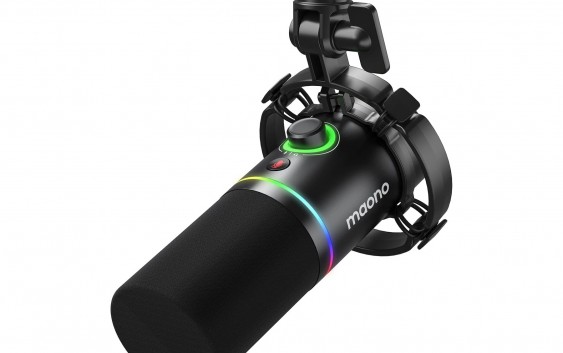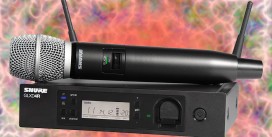Maono PD200X is a surprising standout, bargain, yet quality USB dynamic mic that delivers all the essential features of its class. It is aimed at podcasters, streamers and content creators who want rich audio without a seven-figure budget. All in all, it delivers fantastic value for the price with excellent sound quality, easy setup, and great build. Under the hood it uses a custom dynamic capsule with 40 Hz–16 kHz range and a cardioid polar pattern to help with noise rejection. It capture voices rich and clear, making it ideal for voiceover, gaming chat, podcasting or any sit‑down recording scenario when you don’t necessarily need the top-notch studio quality.
Design, build, unboxing impressions
From first impressions, the PD200X looks like a miniature studio accessory with a distinct ‘gaming’ style, which is in line with current trends. A solid all-metal cylinder with a clean matte finish and a subtle RGB LED ring near the top make for a quality, sturdy build. It has a premium feel despite clearly being a budget device. The box includes the mic, a somewhat light shock-mount, a long USB‑C to USB‑A/C cable, and a screw adapter for mounting on various arms or stands. The included shock-mount is actually plastic, so it’s not as solid as the mic itself — BUT it’s still functional and provides a good deal of the vital shock absorption that the older PD400X model lacked. This mic comes in classic black or a crisp white variant, but either design looks modern and will probably look great on any desk considering the customizable LEDs.
Maono PD200X includes a few handy controls on its body: a one-click mute button (with LED indicator), and a 2‑in‑1 knob that toggles between microphone gain (green light) and headphone volume (blue light). Please be mindful and memorize which color is which, or you might end up muting yourself by mistake! A hidden 3.5 mm headphone jack at the base means you can plug in headphones for real-time zero-latency monitoring. All in all, the PD200X unboxing feels juicy, and almost like a professional setup, kek. However, you’ll need to provide your own XLR cable if you want the analog output for your audio interface because it’s not included.
Audio quality and performance
The PD200X sound is tuned just about right specifically for voice work. It leans towards a slightly warmer bottom and a clear top, making it especially effective for speech-focused content like streaming, voiceovers, or podcasts. Its dynamic capsule captures vocal detail while naturally rejecting room noise—ideal for untreated spaces where ambient sounds can become a problem. Now, with the addition of its cradle shock mount and its decent pop filter, you won’t have to worry about keyboard taps or fan hum bleeding into your recording—this mic has all the mechanisms to keep things tight and controlled.
The overall sound is clear, with a gentle low-mid lift that keeps vocals from sounding too thin. Thanks to the dynamic capsule, it doesn’t sound ‘chirpy’ or brittle; fairly crispy and no mid- scoop like on some cheaper mics, so what you get is a grounded vocal presence—easy to shape with EQ or just leave as it is. There’s a good balance already out of the box.
 Plosives are handled well with the included foam, and louder passages stay smooth rather than spiking or clipping—thanks to the mic’s natural ability to absorb level shifts without introducing those awkward distortion effects. Like most dynamic mics, it works best up close—typically within around 5–8 cm, or closer if you want extra intimacy. Pulling too far away takes some body out of the voice, so keep in mind your distance and adjust based on your mood and energy, not just ‘raw’ volume.
Plosives are handled well with the included foam, and louder passages stay smooth rather than spiking or clipping—thanks to the mic’s natural ability to absorb level shifts without introducing those awkward distortion effects. Like most dynamic mics, it works best up close—typically within around 5–8 cm, or closer if you want extra intimacy. Pulling too far away takes some body out of the voice, so keep in mind your distance and adjust based on your mood and energy, not just ‘raw’ volume.
When placed right, the PD200X gives you a solid, broadcast-style vocal that stays clear and composed—without relying on any DSP tricks or artificial sheen. In USB mode, the mic is plug-and-play with no setup required. Gain can be pushed fairly high—often around 80–100%—without introducing hiss, thanks to a quiet onboard preamp. On XLR, performance remains equally clean, though some interfaces may need near-maximum gain to reach optimal levels. That’s expected for a dynamic mic and not a flaw in the unit.
The overall tone doesn’t aim to feel larger than life or impress with an exaggerated sparkle—it just keeps things simple, clean, and natural, while also offering some resilience to slight changes in axis or distance. So you don’t have to worry much about mic technique just to stay consistent. There’s some warmth in the character, yet it keeps a natural tone in the midrange—crucial for keeping your voice consistent. Overall, I find it easy to work with, and it’s been working reliably so far.
Features, usability, software & applications
The PD200X packs a lot of handy features for the money. On the mic body you get intuitive controls: the big knob is the standout – press it to toggle between adjusting mic gain and headphone output, and the LED color (green vs. blue) shows you which mode you’re in. There’s also a one-touch mute button with a little LED on top, and as mentioned a headphone output at the base for direct monitoring. Everything is “plug-and-play” friendly – you just connect it to your computer via USB‑C and it works immediately, no driver install required. This makes setup a breeze on Windows or Mac (and reportedly it can even work with some Android devices out of the box, though more testing is needed).
The Maono Link software is a really nice bonus—free for PC and Mac, and it unlocks advanced controls in USB mode. With this you can tweak the EQ (there are presets for flat, high-pass filter, presence boost, etc.) and even add a digital limiter or compressor. In short, you can tune the PD200X’s tone and dynamics virtually, without extra hardware. The mic’s RGB ring is also software‑controllable: you get 9 color options to light up the body (press a small button on the bottom to cycle them, or switch the LED off entirely). It’s mostly cosmetic, but it does let you match your PC/gaming rig lighting or just add some pizzazz to your desk.
In everyday use, the PD200X proves highly versatile. It’s perfect for podcasting, live-streaming, voiceovers, video calls, YouTube—basically any scenario where clear spoken audio is key. It’s also great for casual gamers or content creators who want professional sound on a budget. The 3.5 mm monitoring jack is handy, and the plug-and-play USB mode works seamlessly with PCs and laptops. You can also use it with iPads or phones via USB‑C adapters. And for those with pro gear, the XLR output connects to studio mixers, audio interfaces, and whatever else you’ve got.
Pros
|
Cons
|
Conclusion
Overall, the Maono PD200X punches well above its weight for podcasting, streaming, and general voice work. It’s especially compelling if you need both USB and XLR in one package and don’t want to break the bank. It’s also a great choice if you’re after that dynamic ‘broadcaster feel’ on a budget, or just tired of condensers that can sound too hot or overly sibilant sometimes. Its strengths—sound clarity, solid build, and ease of use—make it a smart pick in the sub‑$100 mic class. Great value for money, and the quality is about as good as it gets in this range!
- Reviewed at $69.99









